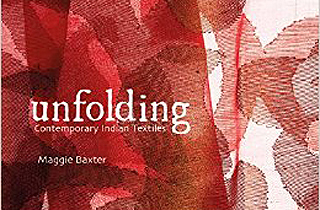Heritage. Antique. Legacy. Vintage. Traditional. Words often used in describing Indian craftsmanship and what is valuable in it. To many a connoisseur of our arts and crafts, words like ‘modern’ and ‘contemporary’ are almost pejorative, ethically empty, antithetical to these values.
Not to Australian artist and curator Maggie Baxter, who prefers capturing the ‘unfolding’ of longstanding techniques in the today and the everyday.
Really, leafing through the photographs—the bulk of the book—easily makes the authenticity clear and impressive. The explanatory captions might be even beside the point for the Indian reader already familiar with many of the traditional, more conventional versions. But they remain a joy to read for the thrill of recognition. This? A gorad sari? In silver and blue? And sometimes they point out intermarriages you might miss—like the jamdani sari on page 47, using Bengali weaving skill to create a chatai pattern inspired by Naga aesthetics.
More importantly, the book becomes a showcase for contemporary Indian designers refashioning our traditions. Some of the names are old hat to those who shop for Page 3-worthy togs—Good Earth, Manish Arora, Bailou, Sanjay Garg/Raw Mango. But there are more niche-appeal artisans as well to celebrate, like Manisha Parekh’s grittily urban yet hearteningly organic paper and silk ‘Pomegranate Bloom’.
The book is organised eclectically too. The chapters progress from Survival and Revival, through Re-View, to Minimalism and Narrative and the fabulous Crossover section, where craft becomes fully adopted as art. Most importantly, for the tourist from overseas or the intrepid urban nomads of our own own nation, there are clues to souvenir collecting… Already, there are items featured in modern collections, like the Abraham & Thakore houndstooth pallu saree woven by Andhra craftsmen, now reposed in the V&A. For those who cannot so invest, this book itself makes as good a collectible as any.




